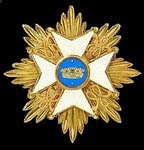First raised 1690. 3 battalions in 1756. Always recruited from the Valais. Ranked 91st in 1756.
This pattern of flags was carried from at least c.1740-1792.
Service (from Susane Vol.7 including extracts translated by me):
1691: Army of Flanders
1692: At the taking of Namur; battle of Steenkerque; bombardment of Charleroi
1693: Battle of Neerwinden
1694: On the march from Wignamont to the bridge of Espierres
1695: Sieges of Dixmude and Deynse; entry into Namur; defence of Namur followed by the Army of the Meuse
1701: In the Low Countries occupying Venloo and Ruremonde for the Spanish king 1702: Parts of the regiment besieged there
1703: At Eckeren: "showed great courage; Captain d'Aulbonne and a boy of 15 years, Louis-François de Courten, son of the colonel, killed there and the lieutenant-colonel, Melchior de Courten, seriously wounded. At the end of the campaign the regiment was sent to Languedoc and spent the next two years campaigning against the Camisards. It contributed greatly in 1704 to the dispersal of the band of Ravenel and killed 200 of its men near Massane."
1706: All three battalions at the siege of Barcelona; combats near Bascara; taking of Figueiras
1707: Capture of Puycerda and Belver. In garrison at Belver; "it destroyed various garrisons in local small forts which hindered the communication of the French army".
1708: Campaigning in Roussillon; recrossed the Pyrenees and took part in the sisge of Tortosa and then marched to the relief of Rosas where part of the regiment managed to get into the town despite an enemy blockade.
1709: Stayed in Roussillon
1710: Siege of Girona; after its capture (which cost the life of Captain Monnin ) became its garrison in January 1711. Trapped there for seven months and then at the end of the campaign sent to the Var.
1712-1713: Served in Roussillon
1714: Siege of Barcelona, which was the last place occupied by the Austrian party in the Peninsula; "distinguished there, the day after the opening of the siege lines, in repelling a sortie with regiments Normandy and Artois. A lieutenant was killed in that engagement. It was also distinguished in the general assault."
1715: To the island of Minorca which submitted after slight resistance from the towns of Alcudia and Palma. Reduced at the peace to two battalions.
1733: Made up to four battalions and stationed on the left bank of the Rhine
1734: At the capture of Trèves and Traerbach; spent the winter at Trèves and in the Hundsrück
1735: The regiment's grenadiers in the combats of Klausen and Salm. The regiment stationed at Phalz and Kick to protect the army's communications as it retired to Trèves.
1737: The regiment reduced to two battalions.
In garrison at Douai for the first campaigns of the War of the Austrian Succession.
1743: The third battalion re-established and sent to Quesnoy.
1744: All three battalions served under Marshal de Saxe
1745: The regiment was compensated for its inaction in the previous campaigns. "After beginning the siege of Tournai, it arrived on the field of battle of Fontenoy. It was part of the brigade of Aubeterre and found itself on the right of the regiment of Gardes Françaises, at the most important part of the battlefield. It was in front of this position that M. du Brocard, commander of the army's artillery, had placed his main gun battery, the battery which could have destroyed the column of the Duke of Cumberland, if the officers of the Gardes Françaises had been willing to put aside their chivalrous courage and be content to fight like soldiers. The rout of the regiment of Gardes Françaises, after an advance which masked the battery of M. Du Brocard, allowed the English column to take the ground on the flank of this battery, and to open, at fifty paces, on it and the regiment of Courten, a murderous volley, which, in an instant, killed all the gunners at their cannon and threw to the ground twenty officers and 209 Swiss soldiers. The brave M. Du Brocard was amongst the first to fall. After him, no-one manned the battery and, in the absence of the guns, a compact column of 16,000 English, engaged in the most reckless manner in the middle of a numerous army, brave and protected by the entrenchments, held this army in check for several hours and almost inflicted on us a defeat which would have been the most shameful of all those that the fate of the arms had inflicted on France. Despite the lightning strike that had just struck it, the regiment of Courten threw itself in front of the English and slowed their advance until the arrival of the regiments of Aubeterre and Du Roi. Courten lost at Fontenoy its lieutenant-colonel Nicolas Marclésy, captains Lecht, Beausobre and Preux, lieutenants La Pierre and Bergerie, ensign Ebiner and 75 NCOs and soldiers. The colonel [Maurice de Courten], 14 officers and more than 200 men were wounded, mostly dangerously. After the victory, the regiment returned to the trenches of Tournai. The regiment served the same year at the capture of Oudenarde, Termonde, Ostend and Nieuport."
1746: Capture of the citadel of Anvers; Captain Huober killed; battle of Rocoux; winter at Anvers
1747: At Malines in April; then arrived late for the battle of Lauffeld brigaded with La Cour au Chantre Regiment. Finished the campaign with the siege of Bergen-op-Zoom, Fort Frederik and Fort Lillo, followed by winter quarters in Anvers again.
1748: March to Bergen -op-Zoom which it was feared would be besieged and there for six months; then to Limburg where it stayed until the Low Countries were entirely evacuated in February 1749
1756: Courten reduced to two battalions 1st April 1756. Originally intended for the army being organised under the Prince de Soubise to help the Austrian Empress but then, when France itself became involved in the war, it was sent to the Army of the Lower Rhine in 1757 and took part in the expedition to Hanover under Marshal Richelieu.
1758: January sent as part of the reinforcements to the Duc de Broglie who was besieging Bemen. Courten helped in the occupation of this town on the 16th January and was then based at Werdhen. At Lutterberg on October 10th.
1759: Under Broglie in Germany
1760: At Warburg on July 31st as part of the Jenner Brigade on the left wing
1761: In Germany
1762: With the Army of the Upper Rhine; back to France in November
1763: Garrisoned Longwy then to Saarlouis in December
And this was the uniform in 1756:



















